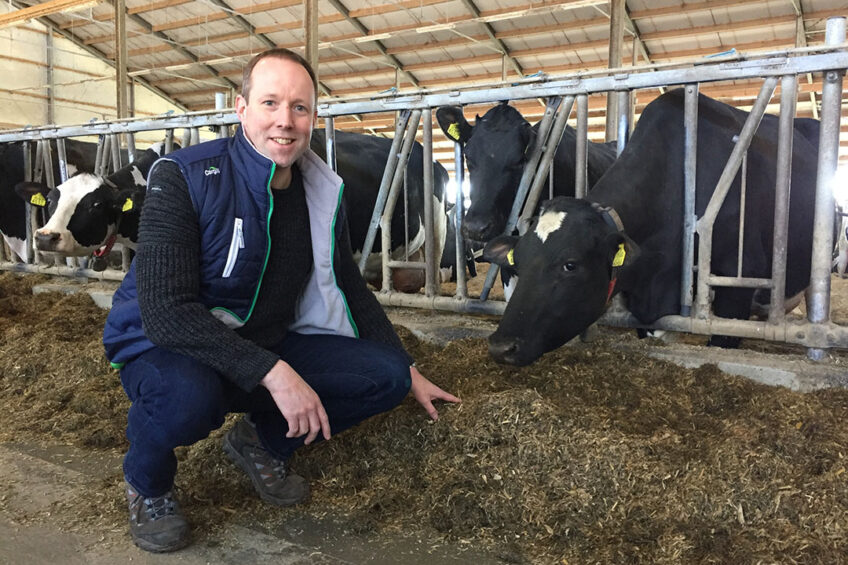A different approach to reducing methane

Cargill and ZELP recently announced a partnership to combat methane emissions in the dairy sector. Their new innovative solution has potential to reduce methane by over 50% and offers new insights into cow health and performance. We talked to Sander van Zijderveld, ruminant strategic marketing and technology lead at Cargill, about combining technology in methane oxidation and data processing to minimise the environmental impact of dairy production. He also tells us why this technology is more than a methane-reducing tool.
There is certainly a race to combat methane emissions within the dairy industry and, although there are already strategies to reduce emissions, the sector welcomes the next step in innovative technology to boost this even further. As much as 95% of an animal’s methane emissions come from its mouth and nostrils; the ZELP technology, which attaches to regular halters, captures and oxidises those emissions, according to Cargill.

Tell me more about this new solution to reduce methane emissions – what makes it different?
The ZELP wearable is completely different as it is wearable. Other solutions that are coming to market to reduce methane are mostly feed additives, which have an impact on the animal’s metabolism or rumen microbes. In contrast, the ZELP wearable acts outside of the cow by capturing the methane as it is released from the nose and mouth of the animal. It is easy to attach, as it is a regular cow halter.
And why partner with ZELP specifically?
We have a clear interest in reducing enteric methane emissions from cattle. We see more and more attention on methane emissions from dairy cows, so we would like to help our farmer base tackle that challenge. If you want to be net zero by 2050, you have to commit and do something about it. To help both the farmers and dairy processors, Cargill has an active research programme on ways to reduce enteric methane emissions. We are also on the lookout for new technologies, and this is how the partnership with ZELP started.
What are some of the challenges you had when developing this technology?
The ZELP team were quite advanced already in developing prototypes that demonstrated quite large methane reductions, so by the time we met them there were no major technological challenges. What we are working on today is to make the device smaller so we have effective prototypes that we can bring to market.

The technology will be available in 2022 to the European market. Why here first?
What we have agreed with ZELP is that we will have our initial focus in Europe as there is a lot of attention on greenhouse gases. There have of course been some changes in some markets, like the US which has a new administration and has made a 180 degree turn on their view on greenhouse gases, so we are seeing interest coming from the US, South America, etc. What we have agreed with ZELP is to see how successful our collaboration is in Europe and sell there first, then expand to other areas. We are still exploring which countries in Europe to access first, and we will ramp up production when we are clear where we are going.
Are Africa, the Middle East and Asia on the agenda as well, and is there any indication of costs to farmers?
Interest is rising everywhere, but an important part of this is to have an incentive system in place. The wearable will of course cost, and in a lot of countries there are no incentives to reduce methane emissions. So this is really important and needs to be put in place. That is also another reason why the roll-out will be Europe first, as there are already some incentives in place. Regarding costs, it’s still too early to tell; we are still producing prototypes. We are currently looking at manufacturing and mass production. Until we know what the production costs will be, we can’t indicate what it will cost European dairy farmers.
Tell me about the animal welfare aspect and the improvement levels
This is another important factor for us: in no way is animal welfare negatively affected. We will also be collaborating with independent experts in this field to assess cows wearing the ZELP wearable, as we want to be completely sure that welfare is not affected negatively. The wearable also has sensors which allow us to detect diseases early on; if there is unusual behaviour, we will be able to pick this up early.
In addition to having environmental benefits, how else is it beneficial?
Lameness, for example, could be detected early as movement of the animals is monitored. Oestrus behaviour and rumination information will also be available with this wearable – from this, a lot can be seen in terms of the health of the animal. Our first priority with this device is that the cow does not show any abnormal behaviour and, second, that we improve animal welfare through early detection of diseases.
Could this technology be used with feed additives to further reduce methane?
In theory yes, but we have not explored that yet. Most feed additives are targeted at preventing methane emissions. Some feed additives now have about a 30% methane reduction potential and 70% will still be coming out of the mouth and nose of the animals; the ZELP device will capture that methane.
In your opinion, is the dairy industry doing enough to tackle methane emissions?
I do think so, yes. Globally, a lot of innovations are being developed that are backed by strong science. Solutions are coming to market; however, we need to have faster application of technologies and innovations. Providing incentives can be a slow process, but also getting some technologies to market does not always happen quickly. For example, some solutions are currently still under review at the European Food Safety Authority, and this has already been the case for five or six years. So on the adoption side of things, improvements could be made to speed up the process.
The partners
ZELP
(Zero Emissions Livestock Project) is a UK company focusing on neutralising methane emissions and improving animal welfare through the use of technology. ZELP was founded in 2017, with the mission to develop groundbreaking technology that plays a major role in agricultural decarbonisation.
Cargill is active in 70 countries and will be the exclusive distributor of the novel device for the European dairy market. In the coming months, Cargill and ZELP will conduct additional testing at the Cargill Research and Development Center and at Wageningen University, one of the world’s leading universities in agriculture, environment and healthy food. Following the completion of testing, the companies expect to launch the ZELP wearable in the second half of 2022. w
Join 13,000+ subscribers
Subscribe to our newsletter to stay updated about all the need-to-know content in the dairy sector, two times a week.










